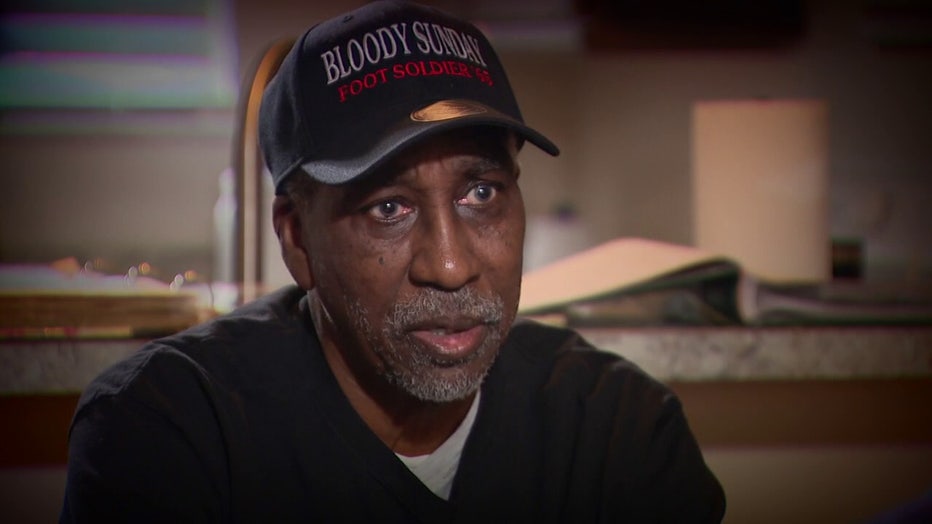America’s Path to Equality: Selma and the Tampa Connection

America?s Path to Equality: Selma and the Tampa Connection
Hundreds of peaceful marchers were beaten in Selma, Alabama on March 7, 1965. It?s known as 'Bloody Sunday,' and it led to a breakthrough on the path to equality ? and specifically for voting rights. Craig Patrick reports.
TAMPA, Fla. - March 7 marks a solemn anniversary in the battle for civil rights.
Hundreds of peaceful marchers were beaten in Selma, Alabama on March 7, 1965. It’s known as 'Bloody Sunday,' and it led to a breakthrough on the path to equality — and specifically for voting rights.
RELATED: America’s Path to Equality: The Selma Movement
Voting rights in 1965
The backstory:
During segregation, governments across the south disenfranchised blacks from voting. They used several techniques – one of the most striking was called a poll exam or a literacy test. The tests varied from state to state.
An aspiring voter might have to print the word vote upside down in the correct order, or draw a square, divided in half from NE to SW, then divided in a broken line from Midwest to Mideast, and write right from the left to the right while bisecting vertical lines or shapes with curved horizontals, or know where the Constitution dictates original jurisdiction when the state is party to a case.
And if they missed anything, they flunked.
"We actually had classes where we would teach voters how to pass the poll tax exam. It was a horrible voter registration campaign, because Birmingham and Alabama didn't want you to be registered to vote," said Birmingham activist Jeff Drew.
Dig deeper:
As an experiment, a Duke University Law Professor sent Alabama's literacy test to 96 Constitutional law professors across the nation. They all failed.
People were exempt from taking the test if they had a grandfather (or ancestor) who was eligible to vote before 1870. That's how the term ‘grandfather clause’ originated, and it's the loophole that exempted whites from taking the test (whites were eligible to vote before 1870 or 1867, while blacks were not).
"Yes, there were all kinds of stumbling blocks to keep you from registering to vote," said civil rights activist and retired Tampa Professor Richard Smiley.

Pictured: Richard Smiley.
Tampa's Path to Equality:
- Part 1: The First Steps
- Part 2: The Awakening
- Part 3: 'Election of the Century'
- Part 4: The Sit-ins
- Part 5: The Breakthrough
- Part 6: The 'Tampa Technique'
- Part 7: Live on Stage
Tampa's connection to Selma
Local perspective:
Smiley spent most of his life in Tampa, but in the 1960s he was living in a foster home 90 miles south of Birmingham in a small town called Selma. A civil rights activist came to town and changed his life
"A gentleman by the name of Bernard Lafayette was in Selma organizing, and we were marching," he said.
The backstory:
Lafayette was born and raised in Tampa. He became one of the original freedom riders who defied segregation in public busing, was beaten for it, and sent to Mississippi's notorious Parchman prison in 1961. After Lafayette was freed, he traveled to Selma.
He helped launch the Student Nonviolent Coordinating Committee (commonly called "Snik"), which inspired students like Smiley, and sparked the Selma movement.
"I used to go to jail every day, every day," said Smiley in describing the peaceful protests. "I just believed all my life. I believe in standing up for what is right."
Why you should care:
As the Selma campaign gained traction, Dr. Martin Luther King Jr. and civil rights activists across the nation took notice. For context, in 1963 they succeeded in Birmingham, in part, because they had the perfect foil in the ruthless police boss Bull Connor.
"Law and order had taken a backseat," said Birmingham activist Jeff Drew. "Bull Connor was the perfect model. He didn’t know it at the time, but he was the perfect model for our campaign."

Pictured: Bernard Lafayette.
Then, in 1964, they said they succeeded in St. Augustine, in part, because they had the perfect foil in motel owner James Brock, who poured jugs of acid into a pool of integrationist protestors.
As they watched the student protests in Selma, and they saw Sheriff James Clark pushing, prodding and jabbing nonviolent demonstrators, and knew they had found the perfect foil again.
Dig deeper:
Dr. King's organization (the SCLC) and the SNIK movement joined forces to turn the national spotlight on Selma and the tactics of Sheriff Clark.
"And everyone in the white power structure of this city must take responsibility for everything Jim Clark does in this community," said Dr. King.
MORE: Is the historic Sanchez Y Haya building actually in Ybor City? One city map says no
Then, on February 18, 1965, a young man named Jimmie Lee Jackson was trying to protect his mother from a police beating near Selma, and a state trooper shot and killed him.
That inspired them to speed up their plans to March 7, with a cold 50-mile march from Selma to the state capitol in Montgomery, and a fateful bloody clash with the forces of Sheriff Clark, and segregationist Governor George Wallace.
This led to the beatings of March 7, 1965, that became known as Bloody Sunday, followed by a triumphant march to Montgomery from March 21-25. As Civil Rights leaders commemorate the 60th anniversary, FOX 13 will continue special coverage throughout the month of March.
The Source: The information in this story was gathered through interviews with civil rights activists as well as research done by FOX 13's Craig Patrick.
WATCH FOX 13 NEWS:
STAY CONNECTED WITH FOX 13 TAMPA:
- Download the FOX Local app for your smart TV
- Download FOX Local mobile app: Apple | Android
- Download the FOX 13 News app for breaking news alerts, latest headlines
- Download the SkyTower Radar app
- Sign up for FOX 13’s daily newsletter

